16 Community Ecology
By the end of this chapter you will be able to:
- Identify different species roles that structure communities
- Describe community dynamics as the changes in community structure that take place over time
- Compare and contrast primary and secondary succession
- Describe the different types of symbiotic relationships that you would find in communities
- Compare and contrast foundation and keystone species
Introduction
Communities are groups of different species interacting with one another and their environment in a given area. They are complex entities characterized by their structure (the types and numbers of species present) and dynamics (how communities change over time). Understanding community structure and dynamics enables community ecologists to manage ecosystems more effectively. An ecosystem is a major interacting system that includes communities of organisms and their physical environment that tend to have classic characteristics associated with them linked together through nutrient cycles and energy flows.
Communities have various species in them, but of particular interest are the foundation species. Foundation species are considered the “base” or “bedrock” of a community, having the greatest influence on its overall structure. They are usually the primary producers: organisms that photosynthesize and bring most of the energy into the community. Kelp, brown algae, is a foundation species, forming the basis of the kelp forests off the coast of California.
Foundation species may physically modify the environment to produce and maintain habitats that benefit the other organisms that use them. An example is the photosynthetic corals of the coral reef (Fig 1). Corals themselves are not photosynthetic, but harbor symbionts within their body tissues (dinoflagellates called zooxanthellae) that perform photosynthesis; this is another example of mutualism, where both species receive a benefit. The exoskeletons of living and dead coral make up most of the reef structure, which protects many other species from waves and ocean currents.
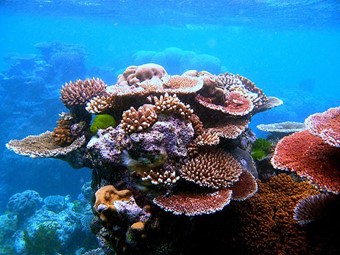
Figure 1: Coral is the foundation species of coral reef ecosystems. Toby Hudson, CC BY-SA 3.0 <https://creativecommons.org/licenses/by-sa/3.0>, via Wikimedia Commons. https://commons.wikimedia.org/wiki/File:Coral_Outcrop_Flynn_Reef.jpg
Biodiversity describes a community’s biological complexity: it is measured by the number of different species (species richness) in a particular area and their relative abundance (species evenness). The area in question could be a habitat, a biome, or the entire biosphere. Species richness is the term that is used to describe the number of species living in a habitat or biome. Species richness varies across the globe (Fig 2). One factor in determining species richness is latitude, with the greatest species richness occurring in ecosystems near the equator, which often have warmer temperatures, large amounts of rainfall, and low seasonality. The lowest species richness occurs near the poles, which are much colder, drier, and thus less conducive to life in Geologic time (time since glaciations). The predictability of climate or productivity is also an important factor. Other factors influence species richness as well. For example, the study of island biogeography attempts to explain the relatively high species richness found in certain isolated island chains, including the Galápagos Islands that inspired the young Darwin. Relative species abundance is the number of individuals in a species relative to the total number of individuals in all species within a habitat, ecosystem, or biome. Foundation species often have the highest relative abundance of species.

Figure 2: The greatest species richness for mammals in North and South America is associated with the equatorial latitudes. (credit: modification of work by NASA, CIESIN, Columbia University)
A keystone species is one whose presence is key to maintaining biodiversity within an ecosystem and to upholding an ecological community’s structure. The intertidal sea star, Pisaster ochraceus, of the northwestern United States is a keystone species (Fig 3).
Studies have shown that when this organism is removed from communities, populations of their natural prey (mussels) increase, completely altering the species composition and reducing biodiversity. Another keystone species is the banded tetra, a fish in tropical streams, which supplies nearly all of the phosphorus, a necessary inorganic nutrient, to the rest of the community. If these fish were to become extinct, the community would be greatly affected.

Figure 3: The Pisaster ochraceus sea star is a keystone species. (credit: Jerry Kirkhart)
Another example of a keystone species can be seen with beavers in many North American ecosystems, particularly in wetland and riparian (streamside) environments. They have a profound influence on their surroundings through their dam-building behavior. Beavers construct dams across streams and rivers using sticks, mud, and stones. These dams have several important ecological effects such as water regulation (which can help maintain stable water levels), habitat creation, and nutrient cycling (by trapping organic matter in the dams). But by far their most significant effect is on promoting high biodiversity in their community. Beavers tend to fell trees of a particular size. They are not interested in a particular species, but rather take down trees of any species that can be used to build their dam. As a result, they tend to take down trees of all species so that no one species of tree can dominate and take over the community.
Invasive species are non-native organisms that, when introduced to an area out of their native range, threaten the ecosystem balance of that habitat. Many such species exist in the United States (Fig 4). Whether enjoying a forest hike, taking a summer boat trip, or simply walking down an urban street, you have likely encountered an invasive species.
Invasive species like purple loosestrife (Lythrum salicaria) and the zebra mussel (Dreissena polymorpha) threaten certain aquatic ecosystems. Some forests are threatened by the spread of common buckthorn (Rhamnus cathartica), garlic mustard (Alliaria petiolata), and the emerald ash borer (Agrilus planipennis). The European starling (Sturnus vulgaris) may compete with native bird species for nest holes.
Regardless of what species is introduced, often there are no native predators and no real competitors to this new species. As a result, the invasive species’ population takes off and its numbers increase rapidly. As a result, invasive species, whether introduced intentionally or on accident, can cause a lot of destruction in the environment.

Figure 4: Invasive species in US forests: (a) common buckthorn, (b) garlic mustard, and (c) the emerald ash borer. (credit a: modification of work by E. Dronkert; credit b: modification of work by Dan Davison; credit c: modification of work by USDA)
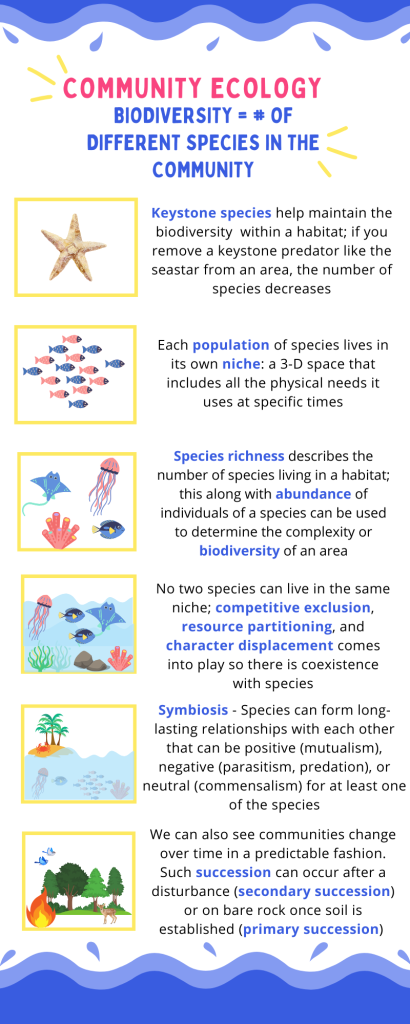
Succession – Predictable Change in a Community
Community dynamics are the changes in community structure and composition over time. Sometimes these changes are induced by environmental disturbances such as volcanoes, earthquakes, storms, fires, and climate change. Communities with a stable structure are said to be at equilibrium. Following a disturbance, the community may or may not return to the equilibrium state.
Succession describes the sequential appearance and disappearance of species in a community over time. In primary succession, newly exposed or newly formed land is colonized by living things; in secondary succession, part of an ecosystem is disturbed, and remnants of the previous community remain.
Primary succession occurs when new land is formed or rock is exposed: for example, following the eruption of volcanoes, such as those on the Big Island of Hawaii. As lava flows into the ocean, new land is continually being formed. On the Big Island, approximately 32 acres of land is added each year. First, weathering and other natural forces break down the substrate enough for the establishment of certain hearty plants and lichens with few soil requirements, known as pioneer species (Fig 5). These species help to further break down the mineral rich lava into soil where other, less hardy species will grow and eventually replace the pioneer species. In addition, as these early species grow and die, they add to an ever-growing layer of decomposing organic material and contribute to soil formation. Over time the area will reach an equilibrium state, with a set of organisms quite different from the pioneer species.
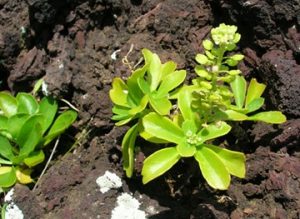
Figure 5: During primary succession in lava on Maui, Hawaii, succulent plants are the pioneer species. (credit: Forest and Kim Starr)
A classic example of secondary succession occurs in oak and hickory forests cleared by wildfire (Fig 6). Wildfires will burn most vegetation and kill those animals unable to flee the area. Their nutrients, however, are returned to the ground in the form of ash. Thus, even when areas are devoid of life due to severe fires, the area will soon be ready for new life to take hold.
Before the fire, the vegetation was dominated by tall trees with access to the major plant energy resource: sunlight. Their height gave them access to sunlight while also shading the ground and other low-lying species. After the fire, though, these trees are no longer dominant. Thus, the first plants to grow back are usually annual plants followed within a few years by quickly growing and spreading grasses and other pioneer species. Due to, at least in part, changes in the environment brought on by the growth of the grasses and other species, over many years, shrubs will emerge along with small pine, oak, and hickory trees. These organisms are called intermediate species. Eventually, over 150 years, the forest will reach its equilibrium point where species composition is no longer changing and resembles the community before the fire. This equilibrium state is referred to as the climax community, which will remain stable until the next disturbance.
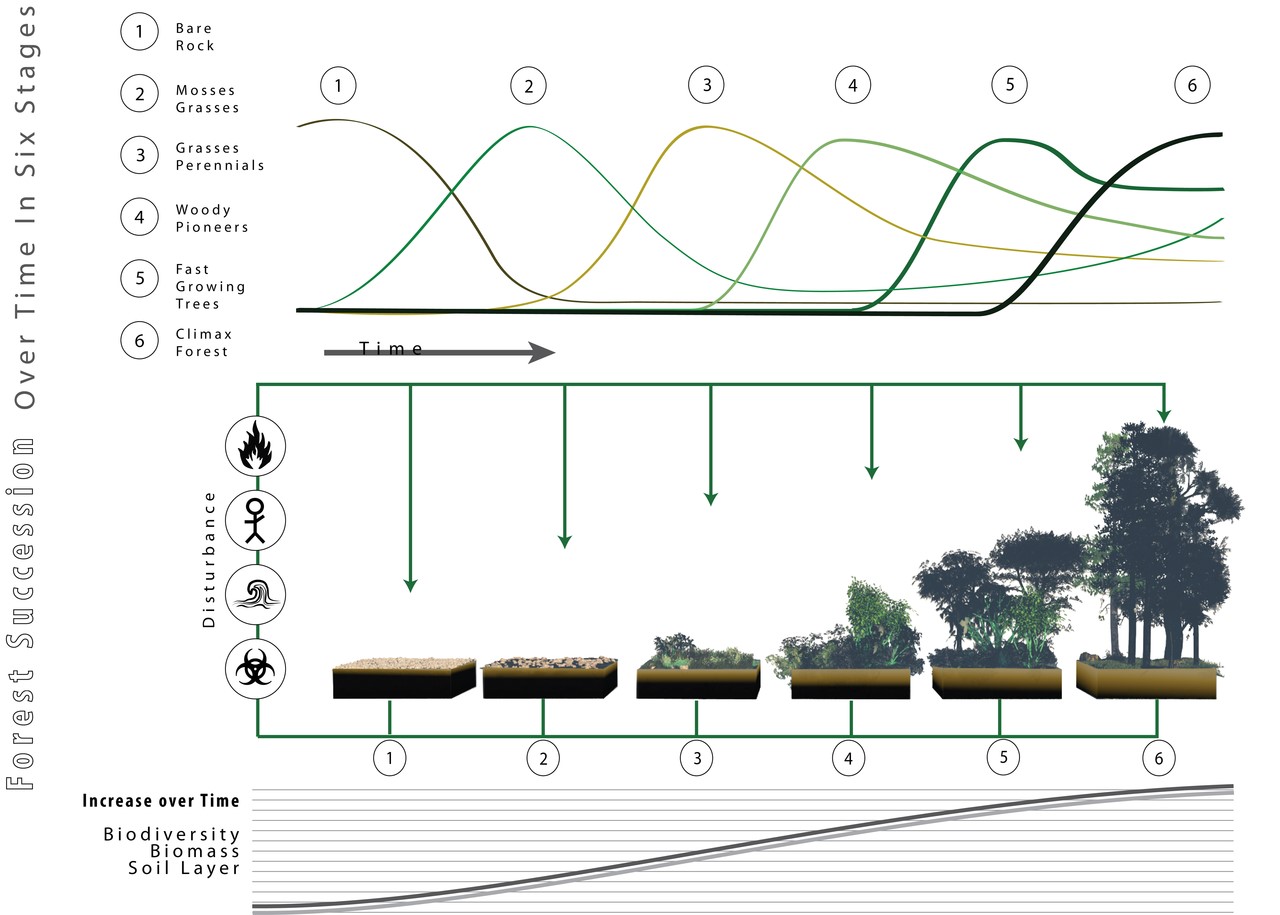
Figure 6: An abstract diagram showing forest succession over time. Increase in biomass, biodiversity and soil thickness are also shown, as well as the fluctuation of different plant communities over the process of succession. LucasMartinFrey, CC via Wikimedia Commons.
If we consider the changes that occur in biological species over time, we expect to see smaller species of plants – weedy, r-selected species at first. Over time, they will be replaced with shrubs. Several decades later, we will find mostly hardwood, K-selected pine species followed by several hundred years later, softwood deciduous trees being the most common. This climax community, such as a mature oak and hickory forest, remains stable until some sort of disturbance resets succession. For example, a fire may set back the successional clock to the pine stage.
As the plant species change in a predictable way over successional time, so too do other types of species. The types of bird species for example will change over early and late succession. While woodpeckers will be most common in pine trees, they will not be found in oak/hickory forests. Instead, you will find birds like ravens, winter wrens, Western tanagers, Cape may warblers, and kinglets (Schleck & Song 2006). You would also expect to see changes in a predictable fashion with mammals, bacteria, fungi, and reptiles.
In general, we see that more species are found over successional time and food web and species interactions get more complex.
Coupled with this are changes that occur with the abiotic environment. The amount of nutrients in the soil will change in a predictable way over successional time. The pH of the soil will drop over time, and the temperature of the soil can decrease overall as trees grow taller and shade is more prevalent.
Watch this short 2+ minute video on the summary of succession and get a great visual and animation to go along with the text above.
Types of Community Interactions between Species
Perhaps the classical example of species interaction is predation: the consumption of prey by its predator. Nature shows on television highlight the drama of one living organism killing another. Populations of predators and prey in a community are not constant over time: in most cases, they vary in cycles that appear to be related. The most often cited example of predator-prey dynamics is seen in the cycling of the lynx (predator) and the snowshoe hare (prey), using nearly 200 year-old trapping data from North American forests (Fig 7). This cycle of predator and prey lasts approximately 10 years, with the predator population lagging 1–2 years behind that of the prey population. As the hare numbers increase, there is more food available for the lynx, allowing the lynx population to increase as well. When the lynx population grows to a threshold level, however, they kill so many hares that hare population begins to decline, followed by a decline in the lynx population because of scarcity of food. When the lynx population is low, the hare population size begins to increase due, at least in part, to low predation pressure, starting the cycle anew.
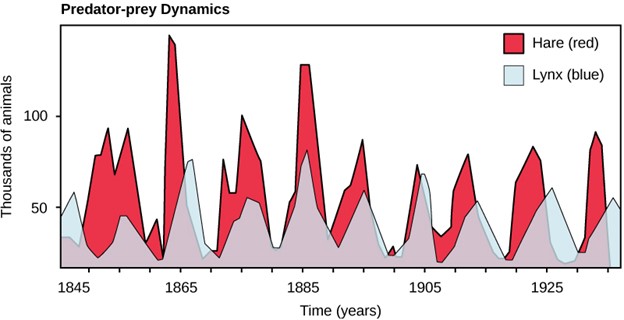
Figure 7: The cycling of lynx and snowshoe hare populations in Northern Ontario is an example of predator-prey dynamics.
Some researchers question the idea that predation models entirely control the population cycling of the two species. More recent studies have pointed to undefined density-dependent factors as being important in the cycling, in addition to predation. One possibility is that the cycling is inherent in the hare population due to density-dependent effects such as lower fecundity (maternal stress) caused by crowding when the hare population gets too dense. The hare cycling would then induce the cycling of the lynx because it is the lynxes’ major food source. The more we study communities, the more complexities we find, allowing ecologists to derive more accurate and sophisticated models of population dynamics.
Herbivory describes the consumption of plants by insects and other animals, and it is another interspecific relationship that affects populations. Unlike animals, most plants cannot outrun predators or use mimicry to hide from hungry animals. Some plants have developed mechanisms to defend against herbivory. Other species have developed mutualistic relationships; for example, herbivory provides a mechanism of seed distribution that aids in plant reproduction.
The study of communities must consider evolutionary forces that act on the members of the various populations contained within it. Species are not static, but slowly changing and adapting to their environment by natural selection and other evolutionary forces. Species have evolved numerous mechanisms to escape predation and herbivory. These defenses may be mechanical, chemical, physical, or behavioral.
Mechanical defenses, such as the presence of thorns on plants or the hard shell on turtles, discourage animal predation and herbivory by causing physical pain to the predator or by physically preventing the predator from being able to eat the prey. Chemical defenses are produced by many animals as well as plants, such as the foxglove which is extremely toxic when eaten (Fig 8).

Figure 8: The (a) honey locust tree (Gleditsia triacanthos) uses thorns, a mechanical defense, against herbivores, while the (b) Florida red-bellied turtle (Pseudemys nelsoni) uses its shell as a mechanical defense against predators. (c) Foxglove (Digitalis sp.) uses a chemical defense: toxins produced by the plant can cause nausea, vomiting, hallucinations, convulsions, or death when consumed. (d) The North American millipede (Narceus americanus) uses both mechanical and chemical defenses: when threatened, the millipede curls into a defensive ball and produces a noxious substance that irritates eyes and skin. (credit a: modification of work by Huw Williams; credit b: modification of work by “JamieS93”/Flickr; credit c: modification of work by Philip Jägenstedt; credit d: modification of work by Cory Zanker)
Many species use physical appearance, such as body shape and coloration, to avoid being detected by predators. The tropical walking stick is an insect with the coloration and body shape of a twig which makes it very hard to see when stationary against a background of real twigs (Fig 9). In another example, the chameleon can, within limitations, change its color to match its surroundings (Fig 9). Both of these are examples of camouflage, or avoiding detection by blending in with the background. There are many behavioral adaptations to avoid or confuse predators. Playing dead and traveling in large groups, like schools of fish or flocks of birds, are both behaviors that reduce the risk of being eaten.
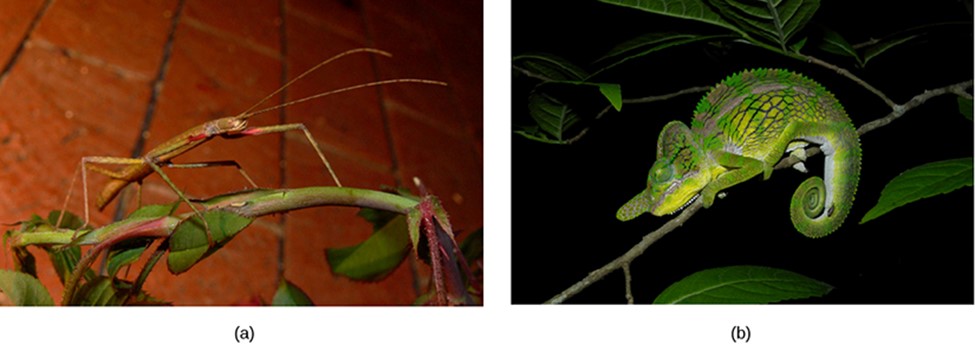
Figure 9: (a) The tropical walking stick and (b) the chameleon use body shape and/or coloration to prevent detection by predators. (credit a: modification of work by Linda Tanner; credit b: modification of work by Frank Vassen)
Some species use coloration as a way of warning predators that they are not good to eat. For example, the cinnabar moth caterpillar, the fire-bellied toad, and many species of beetle have bright colors that warn of a foul taste, the presence of toxic chemicals, and/or the ability to sting or bite, respectively. Predators that ignore this coloration and eat the organisms will experience their unpleasant taste or presence of toxic chemicals and learn not to eat them in the future. This type of defensive mechanism is called aposematic coloration, or warning coloration (Fig 10).
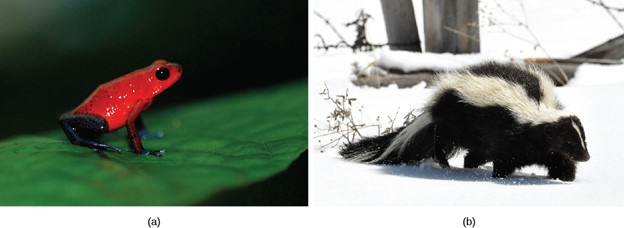
Figure 10: (a) The strawberry poison dart frog (Oophaga pumilio) uses aposematic coloration to warn predators that it is toxic, while the (b) striped skunk (Mephitis mephitis) uses aposematic coloration to warn predators of the unpleasant odor it produces. (credit a: modification of work by Jay Iwasaki; credit b: modification of work by Dan Dzurisin)
While some predators learn to avoid eating certain potential prey because of their coloration, other species have evolved mechanisms to mimic this coloration to avoid being eaten, even though they themselves may not be unpleasant to eat or contain toxic chemicals. In Batesian mimicry, a harmless species imitates the warning coloration of a harmful one. Assuming they share the same predators, this coloration then protects the harmless ones, even though they do not have the same level of physical or chemical defenses against predation as the organism they mimic. Many insect species mimic the coloration of wasps or bees, which are stinging, venomous insects, thereby discouraging predation (Fig 11).
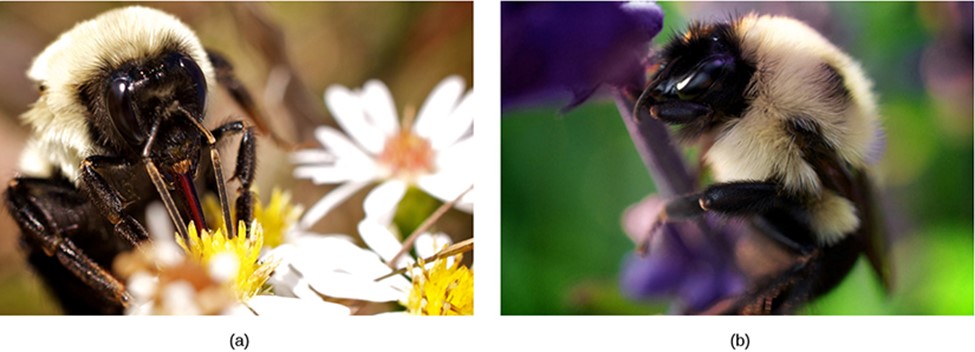
Figure 11: Batesian mimicry occurs when a harmless species mimics the coloration of a harmful species, as is seen with the (a) bumblebee and (b) bee-like robber fly. (credit a, b: modification of work by Cory Zanker)
In Müllerian mimicry, multiple species share the same warning coloration, but all of them actually have defenses, such as the case with a variety of foul-tasting butterflies with similar coloration (Fig 12). In Emsleyan/Mertensian mimicry, a deadly prey mimics a less dangerous one, such as the venomous coral snake mimicking the nonvenomous milk snake. This type of mimicry is extremely rare and more difficult to understand than the previous two types. For this type of mimicry to work, it is essential that eating the milk snake has unpleasant but not fatal consequences. Then, these predators learn not to eat snakes with this coloration, protecting the coral snake as well. If the snake were fatal to the predator, there would be no opportunity for the predator to learn not to eat it, and the benefit for the less toxic species would disappear.
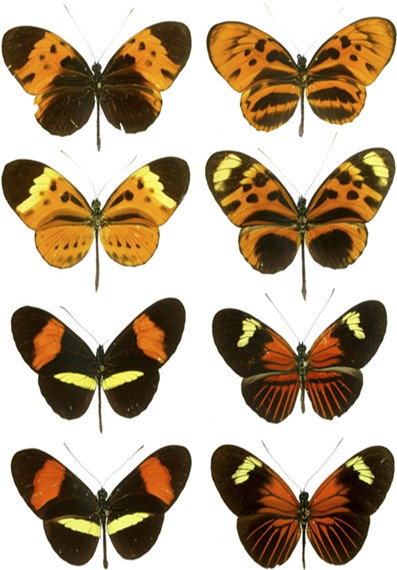
Figure 12: Several unpleasant-tasting Heliconius butterfly species share a similar color pattern with better-tasting varieties, an example of Müllerian mimicry. (credit: Joron M, Papa R, Beltrán M, Chamberlain N, Mavárez J, et al.)
How Different Species Live Together in a Given Area
Resources are often limited within a habitat and multiple species may compete to obtain them. All species have an ecological niche in the ecosystem, which describes how they acquire the resources they need and how they interact with other species in the community. A niche is a 3-dimensional entity that includes all the resources that are needed by an organism and the time in which these resources are used, but can be distinguished at either the hypothetical level, the fundamental niche, or the realized level, the realized niche (Fig 13). The fundamental niche includes all the possible resources and factors as well as the time associated with these but doesn’t take into account competition and predation, and other interacting factors, that will carve out a species’ actual, realized niche.

Figure 13: An ecological niche can be fundamental which includes all the possible resources that are available and if no other interacting factors were present (like competition and predation). An ecological niche can also be realized, which is always a subset of the fundamental niche, and is actually the space, resources and time in which an organism is operating. Taylor Ho, CC via Wikimedia Commons
The competitive exclusion principle states that two species cannot occupy the same niche in a habitat. In other words, different species cannot coexist in a community if they are competing for all the same resources. For example, two protozoan species, Paramecium aurelia and Paramecium caudatum, when grown individually in the laboratory both thrive. But when they are placed together in the same test tube (habitat), P. aurelia outcompetes P. caudatum for food, leading to the latter’s eventual extinction (Fig 14).

Figure 14: Paramecium aurelia and Paramecium caudatum grow well individually (a and b), but when they compete for the same resources, the P. aurelia outcompetes the P. caudatum (c).
This exclusion may be avoided if a population evolves to make use of a different resource, called character displacement, or fine-tunes its realized niche (Fig 15). For example, by moving to a different area of the habitat, or feeding during a different time of day, a new niche is established. This is called resource partitioning. The two organisms are then said to occupy different microniches. These organisms coexist by minimizing direct competition.
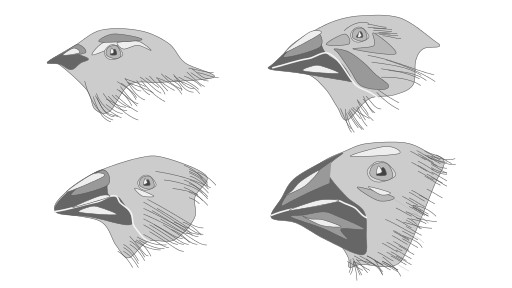
Figure 15: Character displacement occurs when similar species that live in the same geographical region and occupy similar niches differentiate in order to minimize niche overlap and avoid competitive exclusion. Several species of Galapagos finches, shown above, display character displacement. Each closely-related species differs in beak size and beak depth, allowing them to coexist in the same region since each species eats a different type of seed: the seed best fit for its unique beak. The finches with the deeper, stronger beaks consume large, tough seeds, while the finches with smaller beaks consume the smaller, softer seeds. Awakening Conscience, CC via Wikimedia Commons
Watch this neat video on woodpeckers, aye-aye lemurs and resource partitioning below.
When we find different species living together in a given area, we often will find symbioses (plural). Symbiotic relationships are close interactions between individuals of different species over an extended period of time which impact the abundance and distribution of the associating populations.
A commensal relationship occurs when one species benefits from the close, prolonged interaction, while the other neither benefits nor is harmed. Birds nesting in trees provide an example of a commensal relationship. The tree is not harmed by the presence of the nest among its branches. The nests are light and produce little strain on the structural integrity of the branch, and most of the leaves, which the tree uses to get energy by photosynthesis, are above the nest so they are unaffected. The bird, on the other hand, benefits greatly. If the bird had to nest in the open, its eggs and young would be vulnerable to predators. Another example of a commensal relationship is the pilot fish and the shark. The pilot fish feed on the leftovers of the host’s meals, and the host is not affected in any way.
A second type of symbiotic relationship is called mutualism, where two species benefit from their interaction. Some scientists believe that these are the only true examples of symbiosis. For example, termites have a mutualistic relationship with protozoa that live in the insect’s gut (Fig 16a). The termite benefits from the ability of bacterial symbionts within the protozoa to digest cellulose. The termite itself cannot do this, and without the protozoa, it would not be able to obtain energy from its food (cellulose from the wood it chews and eats). The protozoa and the bacterial symbionts benefit by having a protective environment and a constant supply of food from the wood chewing actions of the termite. Lichens have a mutualistic relationship between fungus and photosynthetic algae or bacteria (Fig 16b). As these symbionts grow together, the glucose produced by the algae provides nourishment for both organisms, whereas the physical structure of the lichen protects the algae from the elements and makes certain nutrients in the atmosphere more available to the algae.

Figure 16: (a) Termites form a mutualistic relationship with symbiotic protozoa in their guts, which allow both organisms to obtain energy from the cellulose the termite consumes. (b) Lichen is a fungus that has symbiotic photosynthetic algae living inside its cells. (credit a: modification of work by Scott Bauer, USDA; credit b: modification of work by Cory Zanker)
A third type of symbiosis is parasitism. A parasite is an organism that lives in or on another living organism and derives nutrients from it. In this relationship, the parasite benefits, but the host is harmed. The host is usually weakened by the parasite as it siphons resources the host would normally use to maintain itself. The parasite, however, is unlikely to kill the host, especially not quickly, because this would allow no time for the organism to complete its reproductive cycle by spreading to another host.
The reproductive cycles of parasites are often very complex, sometimes requiring more than one host species. A tapeworm is a parasite that causes disease in humans when contaminated, undercooked meat is consumed (Fig 17). The tapeworm can live inside the intestine of the host for several years, benefiting from the food the host is eating, and may grow to be over 50 ft long by adding segments. The parasite moves from species to species in a cycle, making two hosts necessary to complete its life cycle.
Another common parasite is Plasmodium falciparum, the protozoan cause of malaria, a significant disease in many parts of the world. Living in human liver and red blood cells, the organism reproduces asexually in the gut of blood-feeding mosquitoes to complete its life cycle. Thus malaria is spread from human to human by mosquitoes, one of many arthropod-borne infectious diseases.

Figure 17: This diagram shows the life cycle of a pork tapeworm (Taenia solium), a human worm parasite. (credit: modification of work by CDC)
Summary
Communities are full of life, where we find different species interacting with each other in a given habitat. The interactions are often symbiotic in nature, where we can find two species involved with each other permanently in different ways: positive (mutualism), negative (parasitic, predator/prey), or in a neutral way (commensalism – only one species benefits and the other is not harmed or helped). Such interactions can be found at different times if we focus on successional change. Succession is the predictable and orderly series of events that occur in an area over time. And there are two types of succession: primary and secondary succession describe how communities develop and change over time in response to disturbances or environmental changes.
Primary succession refers to the process of community development in an area that has never been colonized by living organisms or one where all living organisms have been completely removed, such as in the aftermath of a volcanic eruption, the formation of new land (e.g., a newly formed island), or the retreat of a glacier. Pioneer species come in initially and can survive in harsh conditions which can lead to soil formation and subsequent successional stages. Primary succession can take centuries to millennia to reach a climax community, which is a stable, self-sustaining ecosystem.
Secondary succession, on the other hand, occurs in an area that has experienced a disturbance that disrupts an existing community but does not completely destroy the soil. Common causes of secondary succession include forest fires, hurricanes, logging, or abandoned agricultural fields.
Once communities are established, there may be competition if two species are competing for the same niche. In this case, we may find that one wins over time in a process called competitive exclusion. Coexistence may be possible if one (or both) species adapt to their environment in different ways leading to character displacement.
Questions
Glossary
References
Clark, M., Choi, J., and Douglas, M. Symbiosis from Biology 2e for Biol 111 and Biol 112.
Kosal, E. 2023. Summary. NC State University.
Lumen Learning. Succession from Fundamentals of Biology I.
Schleck, J and Song, SJ. 2006. Changes in bird communities throughout succession following fire and harvest in boreal forests of western North America: literature review and meta-analyses. Can J For. Res. 36, 1299-1318. doi/pdf/10.1139/x06-017

